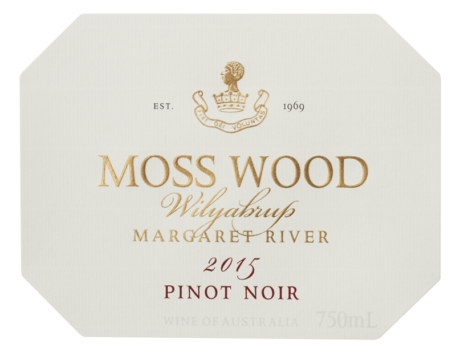Moss Wood 2015 Pinot Noir

Wine Facts
| Median Harvest Date: | 10/02/2015 |
| Bottled: | 21/11/2016 |
| Released: | 20/08/2017 |
| Yield: | 3.64 t/ha |
| Harvest Ripeness: | 13.8°Be |
| Alcohol: | 14% |
It is not news that the Margaret River Wine Region is internationally recognised as a premium producer of Cabernet Sauvignon and Chardonnay and Moss Wood is well known for its cabernet. However, our Pinot Noir often flies under the radar and it is not uncommon to hear customers remark they didn’t know we make it.
It’s ironic because we were very early adopters in Australia of pinot noir and chardonnay and their quality has been acclaimed throughout the years. Perhaps our efforts in promoting our Chardonnay and Pinot Noir haven’t been up to the mark.
Bill and Sandra Pannell were keen to grow the great grape varieties of France, certainly from Bordeaux but also from Burgundy. From the latter they planted Pinot Noir in 1973 and Chardonnay, as soon as cuttings became available in Western Australia, in 1976. Their first vintages were 1977 and 1980, respectively. The great red and white wines of Burgundy remain the reference point for us, although we are not trying to recreate the Cote D’Or in Wilyabrup. The wines are true to their sense of place.
Our point is, those who don’t know about Moss Wood Chardonnay and Moss Wood Pinot Noir are missing out on two of the dark horses in the Moss Wood stable.
Tasting Notes
Colour and condition: Medium to deep ruby hue. Condition is bright
Nose: A floral and scented nose with a bright combination of strawberry, cherries, quince jelly and musk. In the background there are soft oak notes and just a touch of earthiness.
Palate: This displays the same intense fruit notes of the nose, with generous strawberry fruit flavours, medium weight, good acid and tannin balance and great length.
Moss Wood 2022 Pinot Noir – Huon Hooke, The Real Review
Margaret River isn’t one of the great pinot noir regions, consequently there are very few made there. This is the best Moss Wood pinot noir I’ve tasted for many years. Youthful red-purple colour, bright and deep. There are cherry, ginger and iodine/peat aromas which are bright and fresh and fruit…
Vintage Notes
The 2015 Moss Wood Pinot Noir was the product of a growing season that was one of our wettest ever. For the record, in calendar year 2014 Mother Nature dumped 1,245 mm of rain on us and we’d like to use this to highlight a little known fact about us. In an era when very few Australian vineyards are dry farmed, both Moss Wood and Ribbon Vale remain unirrigated.
The explanation isn’t difficult to understand if we consider the amount of rain we get. Our average rainfall is 1003mm, significantly wetter than the area where Keith grew up, McLaren Vale in South Australia, where mean annual rainfall is 500mm. Vines get plenty of water from the sky in Margaret River and during the 39 growing seasons Keith has experienced at Moss Wood, the crop has virtually never been adversely affected by drought. Instead, our yields have been limited by events associated with wet conditions – rainfall at the wrong time, hail, heavy winds and so on and the 2015 Pinot is a classic example.
High yield is not a priority at Moss Wood, our emphasis is on quality, so how do we compare? The Australian benchmark for yield, across all varieties, is around 12t/ha (tonnes per hectare) but Moss Wood Pinot Noir yield is 6.3 t/ha. Not unreasonably, people may look at that difference and wonder how lower yielding vineyards could be viable. The answer is in the quality produced – the better the quality the higher the price a wine can achieve in the market. The reality for a cool, wet region like Margaret River is high yields can be a serious threat to quality because we don’t get sufficient warmth to properly ripen big crops, even with an early ripening cultivar like Pinot Noir. The natural irrigation we get from Mother Nature is more than enough to sustain quality yields.
Which leads us back to the 2015 Pinot Noir with its heroically small yield of 3.64 t/ha and a classic example of how our conditions can count against us. We have two clones which flower at slightly different time and results in a flowering period of around 28 days. Through that time in 2014 we had 16 days of rain, for a total of 68mm, all of which disrupted pollination, not to mention the 12 nights where the temperature dropped below 8⁰C causing all recently opened flowers to give up altogether. No surprise that we lost some bunches and those that remained were about half normal weight.
Much more important is how the season affected wine quality and the news is all good.
In future, we are sure people will wax lyrical about the last decade of Margaret River vintages and when they do, 2015 will be one of the shining stars. The Pinot Noir enjoyed many hours (949, in fact) in the ideal temperature range of 18-28⁰C and along with that, virtually no extreme heat. The hottest day was 37⁰C and in fact the vines only received 33 hours above 33⁰C, almost verging on too cool.
Suffice to say, ripening was slow and easy, with the vines taking 106 days to get from flowering to harvest, 6 days longer than average. The ripeness of 13.8⁰ Baume, was slightly above the average of 13.4⁰ and the fruit was in excellent condition, with no disease or bird damage.
All picking was by hand and started on 6th February.
Production Notes
The fruit was delivered to the winery where it was sorted, destemmed and placed into small, open fermenters. Fermentation was by multiple yeast strains, plunging for extraction of colour and flavour was done 3 times per day and temperatures were controlled to a maximum of 32⁰C. The various batches were pressed after 15 days on skins and were put into 228 litre French oak barrels, 20% of which were new and where the wine stayed for 20 months.
At the end of maturation the barrels were blended and assessed for tannin balance. Fining trials showed the wine had excellent balance and did not need adjustment. It was then sterile filtered and bottled on 21st November 2016.
Cellaring Notes
As with all Moss Wood Pinot Noir wines, the 2015 has generous fruit and good balance and so can easily be enjoyed now. However, it will definitely repay those patient souls who are prepared to tuck it away in their cellars. Until the wine reaches 10 years of age, the primary red fruits will be the dominant feature but in the decade following, the classic old Pinot Noir bottle bouquet will reveal itself. This means the strawberry and cherry fruit will have a background of complexity, made up of unusual farmyard notes – earth, tar, meat and leather. Into its third decade, the wine will reach full maturity, such as required by the patient ones and the complex notes will be the dominant feature. A likely final “drink by” date is difficult to predict but all our old Pinots continue to age well into their fourth decade and we expect the 2015 will do the same.

